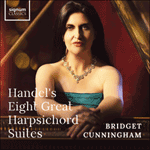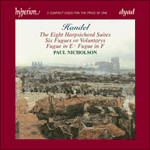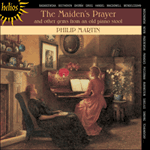Suite No 5 in E major is a step further up the cycle of fifths from ‘youthful’ A major and E is the sharpest (and ‘highest’) key in general use. It was traditionally associated with heaven, but in the works of Handel it would seem that paradise is firmly terrestrial. True, the free-flowing prelude, the allemande and the courante are all lucidly gracious, but Handel dispenses with a sarabande and as his finale offers a variation-set on a tune so earthy in metrical symmetry and diatonic in harmonization that it quickly won the popular title of ‘The Harmonious Blacksmith’. Again, Handel steers aristocratic finesse towards a rawly demotic future. Though Handel’s blacksmith, benign in harmony, may attempt celestial levitation in the shooting scales of his final variation, the effect is more comic than transcendent.
from notes by Wilfrid Mellers © 1995
La
Suite no5 en mi majeur se situe à un échelon plus élevé dans le cycle de quintes au ton «jeune» de la majeur, et est composée dans la clé la plus diésée (et la plus «haute») habituellement utilisée. Cette tonalité était traditionnellement associée au paradis, mais les œuvres de Hændel semblent indiquer que le paradis est bel et bien terrestre. Il est vrai que le Prélude fluide, l’Allemande et la Courante sont gracieux et lucides, mais Hændel supprime la Sarabande et offre comme Finale une série de variations sur une mélodie qui fut bientôt surnommée «Le Forgeron Harmonieux», à cause de sa grande symétrie métrique et de son harmonie diatonique. Encore une fois, Hændel dirige la finesse aristocratique vers un avenir âpre et démotique. Même si le forgeron de Hændel, de ses harmonies légères, semble tenter une lévitation céleste dans les gammes ascendantes de sa dernière variation, l’effet est plus comique que transcendant.
extrait des notes rédigées par Wilfrid Mellers © 1995
Français: Isabelle Dubois
Die
Suite Nr. 5 in E-Dur geht innerhalb des Quintenzirkels einen Schritt weiter als das „jugendliche“ A-Dur und ist die schrillste (und „höchste“) allgemein benutzte Tonart. Traditionell wurde sie mit dem Himmel in Verbindung gebracht, aber im Werke Händels scheint es, als sei das Paradies fest auf Erden verankert. Zwar sind das frei dahinfließende Präludium, die Allemande und die Courante alle von einer lichten Anmut, doch verzichtet Händel auf eine Sarabande und bietet als Finale einen Satz von Variationen über eine Melodie, die in ihrer metrischen Symmetrie und diatonischen Harmonik so irdisch klingt, daß sie sich bald den populären Titel „Der harmonische Grobschmied“ erwarb. Wieder einmal lenkt Händel hier aristokratische Feinheit in eine unverbrämt volkstümliche Zukunft. Obwohl Händels durch milde Harmonien gekennzeichneter Grobschmied in den jagenden Läufen seiner letzten Variation ein Emporschweben in die himmlischen Sphären anstreben mag, so ist der erzielte Effekt doch eher komisch als transzendental.
aus dem Begleittext von Wilfrid Mellers © 1995
Deutsch: Angelika Malbert





 Handel: Eight Great Harpsichord Suites
Handel: Eight Great Harpsichord Suites Handel: Harpsichord Suites
Handel: Harpsichord Suites The Maiden's Prayer
The Maiden's Prayer
